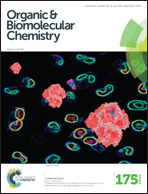Enhancement of the properties of a drug by mono-deuteriation: reduction of acid-catalysed formation of a gut-motilide enol ether from 8-deuterio-erythromycin B†
Abstract
Erythromycin B is structurally very similar to erythromycin A, and also shares its clinically important antibacterial activity. Its potential advantage is that it is much more stable to acid. Both compounds are susceptible to 6–9-enol ether formation, involving loss of a proton from C-8. The enol ethers lack antibacterial activity and can give rise to unpleasant gut motilide side-effects. Our previous work on degradation kinetics revealed that the formation of erythromycin B enol ether from erythromycin B is subject to a large deuterium isotope effect. We therefore synthesized 8-d-erythromycin B (in 87% yield) in the hope that acid-catalysed enol ether formation would be reduced, relative to erythromycin B. In a range of microbiological and biochemical assays, deuteriation did not appear to compromise the efficacy of the drug. Degradation studies showed, however, that incorporation of deuterium into erythromycin B reduces (though does not completely suppress) enol ether formation, providing the possibility of using a facile mono-deuteriation to reduce the gut motilide side-effects of the drug.


 Please wait while we load your content...
Please wait while we load your content...